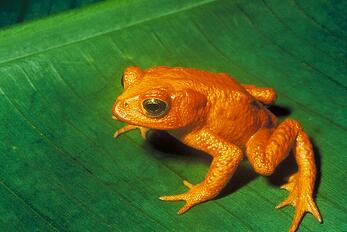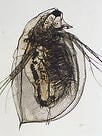 Despite 400 million years of evolutionary success, amphibians are dying out, thanks to habitat loss, increased levels of UV radiation, invasive species, climate change, emerging infectious diseases, and agricultural contaminants. These factors all make the frog's life and that of his fellow cold-blooded tetrapods harder and harder. Realistically, it's nearly impossible to address most of the factors contributing to his endangerment in the time frame needed to stave off extinction.
Despite 400 million years of evolutionary success, amphibians are dying out, thanks to habitat loss, increased levels of UV radiation, invasive species, climate change, emerging infectious diseases, and agricultural contaminants. These factors all make the frog's life and that of his fellow cold-blooded tetrapods harder and harder. Realistically, it's nearly impossible to address most of the factors contributing to his endangerment in the time frame needed to stave off extinction.
[The Golden toad of Monteverde, Costa Rica, courtesy of Wikipedia]
Fortunately, one very serious threat to amphibian survival is a fungal pathogen, and zoology researchers at Oregon State University may have just discovered a bug that will eat the fungi that's killing the frogs, caecilians, and salamanders. It's the best sort of disease eradication plan, because it's getting Nature to fix the problem through biological control rather than using fungicides and possibly making the habitat worse.
 The bug under the microscope in the recent study is a tiny zooplankton, called Daphnia magna (left), and the fungus the infamous Batrachochytrium dendrobatidis ("chytrid fungus"), which causes the deadly disease chytridiomycosis. According to Julia Buck, an OSU doctoral student in zoology and lead author on the study, published in the journal Biodiversity and Conservation:
The bug under the microscope in the recent study is a tiny zooplankton, called Daphnia magna (left), and the fungus the infamous Batrachochytrium dendrobatidis ("chytrid fungus"), which causes the deadly disease chytridiomycosis. According to Julia Buck, an OSU doctoral student in zoology and lead author on the study, published in the journal Biodiversity and Conservation:
“There was evidence that zooplankton would eat some other types of fungi, so we wanted to find out if Daphnia would consume the chytrid fungus. Our laboratory experiments and DNA analysis confirmed that it would eat the zoospore, the free-swimming stage of the fungus.” This is particularly important because it is the aquatic stage of the chytrid zoospore that is infective.
 Amphibians are sometimes referred to as ecological indicators, meaning that they give us information about the health of larger ecosystems and the impact of human activities on those systems. So while the tree frogs in your backyard may seem to be reproducing happily, the extinction of other varieties, like the Golden Toad of Monteverde, Costa Rica (above) and the overall reduction in amphibian species diversity signals dangers to their ecosystems as a whole. Of course, introducing another species into an ecosystem for the purpose of biological control, which is what the OSU team proposes, could be calamitous if it were a non-native bug. Daphnia magna however it is already present in the amphibian habitat, and may account for why some populations are surviving the attack of the chytrid fungus better than others. It may not be necessary to completely eliminate it, but rather just reduce its density through bioaugmentation, in this case with daphnia magna. Field testing will be the next step for OSU researchers, including Dr. Andrew Blaustein, a professor of zoology, co-author on this study, and an international leader in the study of amphibian decline.
Amphibians are sometimes referred to as ecological indicators, meaning that they give us information about the health of larger ecosystems and the impact of human activities on those systems. So while the tree frogs in your backyard may seem to be reproducing happily, the extinction of other varieties, like the Golden Toad of Monteverde, Costa Rica (above) and the overall reduction in amphibian species diversity signals dangers to their ecosystems as a whole. Of course, introducing another species into an ecosystem for the purpose of biological control, which is what the OSU team proposes, could be calamitous if it were a non-native bug. Daphnia magna however it is already present in the amphibian habitat, and may account for why some populations are surviving the attack of the chytrid fungus better than others. It may not be necessary to completely eliminate it, but rather just reduce its density through bioaugmentation, in this case with daphnia magna. Field testing will be the next step for OSU researchers, including Dr. Andrew Blaustein, a professor of zoology, co-author on this study, and an international leader in the study of amphibian decline.
All of which is very good news for the biosphere. Amphibians have become so popular recently that businesses have made them into mascots and used images of their cute little bodies to promote sales. But that doesn't help the reality of their situation, which is alarming. Controlling the fungal threat may just give researchers and policy-makers the time they need to find solutions to larger threats to the amphibians' (and our) biosystems.
Biotechnology Calendar Inc. will be on the OSU campus in Corvallis the second week in October, holding our 6th Annual BioResearch Product Faire event on the OSU campus October 12, 2011. For research funding data on OSU and information on the October tradeshow/marketing event, click the button below:


